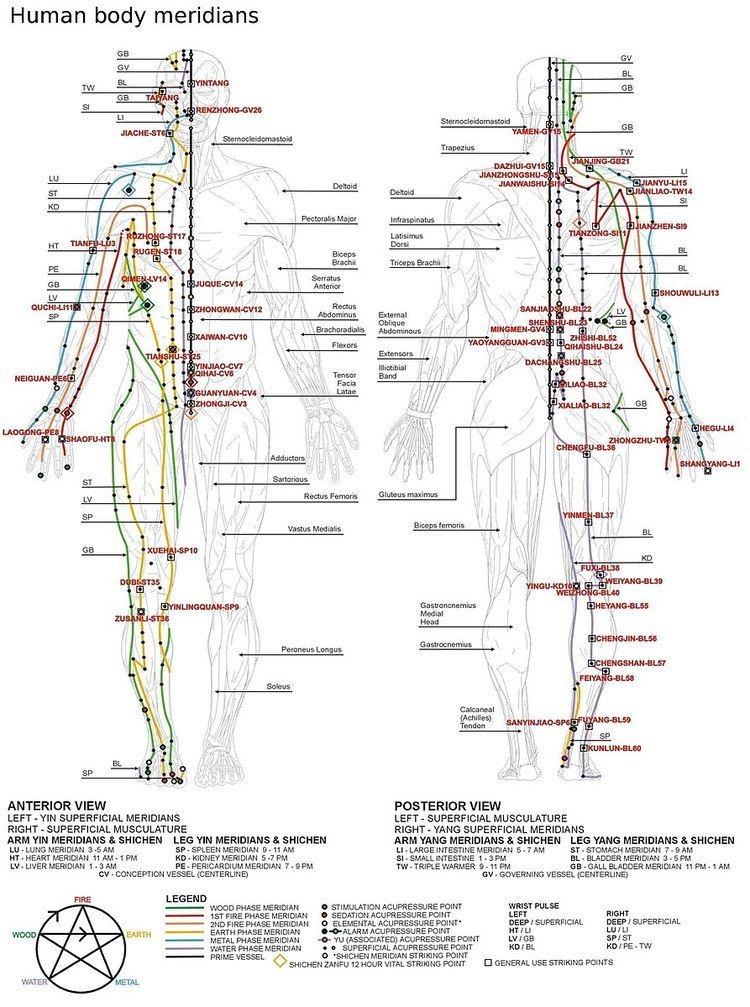 | ||
Shiatsu (Kanji: 指圧; Hiragana: しあつ) is a form of Japanese bodywork based on the theoretical framework of traditional Chinese medicine.
Contents
In the Japanese language, shiatsu means "finger pressure". Shiatsu techniques include massages with fingers, thumbs, feet and palms; assisted stretching; and joint manipulation and mobilization. To examine a patient, a shiatsu practitioner uses palpation and, sometimes, pulse diagnosis.
The word Shiatsu is Japanese. “Shi-” refers to finger, and “-atsu” means pressure. The Japanese Ministry of Health defines shiatsu as “a form of manipulation by thumbs, fingers and palms without the use of instruments, mechanical or otherwise, to apply pressure to the human skin to correct internal malfunctions, promote and maintain health, and treat specific diseases. The techniques used in shiatsu include stretching, holding, and most commonly, leaning body weight into various points along key channels.”
Shiatsu derives from a Japanese massage modality called anma which was itself adapted from tui na. Tui na is a Chinese bodywork system that arrived in Japan by at least the Nara period (710–793 CE). Tokujiro Namikoshi (1905–2000) founded a shiatsu college in the 1940s, and is often credited with inventing modern shiatsu.
There is no evidence that shiatsu is an effective medical treatment.
History
Shiatsu evolved from anma, a Japanese massage modality developed in 1320 by Akashi Kan Ichi. Anma was popularised in the seventeenth century by acupuncturist Sugiyama Waichi, and around the same time the first books on the subject, including Fujibayashi Ryohaku's Anma Tebiki ("Manual of Anma"), appeared.
The Fujibayashi school carried anma into the modern age. Prior to the emergence of shiatsu in Japan, masseurs were often nomadic, earning their keep in mobile massage capacities, and paying commissions to their referrers.
Since Sugiyama's time, massage in Japan had been strongly associated with the blind. Sugiyama, blind himself, established a number of medical schools for the blind which taught this practice. During the Tokugawa period, edicts were passed which made the practice of anma solely the preserve of the blind – sighted people were prohibited from practicing the art. As a result, the "blind anma" has become a popular trope in Japanese culture. This has continued into the modern era, with a large proportion of the Japanese blind community continuing to work in the profession.
Abdominal palpation as a Japanese diagnostic technique was developed by Shinsai Ota in the 17th century.
During the Occupation of Japan by the Allies after World War II, traditional medicine practices were banned (along with other aspects of traditional Japanese culture) by General MacArthur. The ban prevented a large proportion of Japan's blind community from earning a living. Many Japanese entreated for this ban to be rescinded. Additionally, writer and advocate for blind rights Helen Keller, on being made aware of the prohibition, interceded with the United States government; at her urging, the ban was rescinded.
Tokujiro Namikoshi (1905–2000) founded his shiatsu college in the 1940s and his legacy was the state recognition of Shiatsu as an independent method of treatment in Japan. He is often credited with inventing modern shiatsu. However, the term shiatsu was already in use in 1919, when a book called Shiatsu Ho ("finger pressure method") was published by Tamai Tempaku. Also prior to Namakoshi's system, in 1925 the Shiatsu Therapists Association began, with the purpose of distancing shiatsu from Anma massage.
Namikoshi's school taught shiatsu within a framework of western medical science. A student and teacher of Namakoshi's school, Shizuto Masunaga, brought shiatsu back to traditional eastern medicine and philosophic framework. Masunaga grew up in a family of shiatsu practitioners, with his mother having studied with Tamai Tempaku. He founded Zen Shiatsu and the Iokai Shiatsu Center school. Another student of Namakoshi, Hiroshi Nozaki founded the Hiron Shiatsu a holistic technique of shiastu that uses intuitive techniques and spiritual approach to healing which identifies ways how to take responsibility for a healthy and happy life in your own hands. It is practiced mainly in Switzerland, France and Italy where its founder opened several schools.
Usefulness
There is no evidence that shiatsu is an effective medical treatment. In 2015 the Australian Government's Department of Health published the results of a review of alternative therapies that sought to determine if any were suitable for being covered by health insurance; shiatsu was one of 17 therapies evaluated for which no clear evidence of effectiveness was found.
Contemporary research has not demonstrated the existence of qi or meridians. So far, studies researching shiatsu's effectiveness have been poorly executed.
According to Cancer Research UK, "There is no scientific evidence to prove that shiatsu can cure or prevent any type of disease, including cancer. Also, a lack of high quality research so far means there is currently no scientific evidence to support the use of shiatsu for controlling cancer symptoms. This doesn't mean that shiatsu doesn't work in controlling symptoms or side effects, simply that it has not yet been tested properly."
